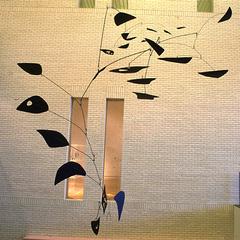Curriculum Materials: Art in America
|
|
Image 24 Alexander Calder Questions: |
Think Questions Teacher Answer Key
1. What do you think this MOBILE represents? What makes you think so? Does the title Ahab give you any clues?
2. Calder intended that this MOBILE evoke aspects of the natural world. How does he accomplish this goal? Consider: shapes, lines, color, SCALE, COMPOSITION, source that drives its movements.
3. Why do you suppose Calder chose to make this MOBILE completely black? (Accept all answers.) How would you interpret this mobile differently if all of the forms were green? Blue? Many colors?
4. You can see many parts of the MOBILE and how it is put together. What element of the mobile can you not see? (Movement.) If you were going to make a reproduction that captures this missing element, how would you do it? Could you make any kind of reproduction that would capture all aspects of experiencing this sculpture?
5. Have you ever seen a MOBILE? Where? How big was it? Was it ABSTRACT or did it have a recognizable subject? Did you consider it a work of art? Why or why not? Would you consider it a work of art now that you have studied Alexander Calder's mobile?
6. Compare and contrast Calder's
MOBILE
Ahab with George
Morrison's Collage IX: Landscape. What do these two
artworks have in common?
(THREE-DIMENSIONAL,
ABSTRACT, constructed
from many pieces, both allude to an idea rather than depict
it directly.) How do they differ? (The
mobile moves, while the
COLLAGE is still; the
mobile is very open and spacious,
and the collage is very dense; the
mobile is painted black, while the
collage has multiple colors and textures.)
|
|
